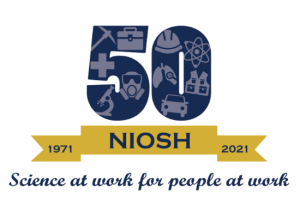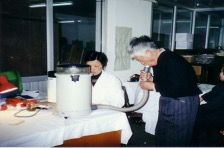Lung Disease in Textile Workers
Posted on by
This blog is part of a series for NIOSH’s 50th anniversary highlighting research and prevention throughout the Institute’s history.
Background
Since the 1970s, NIOSH has worked to prevent illness from cotton dust. Byssinosis is an airways disease with features of both asthma and COPD that occurs with exposure to cotton dust. In the early 1970s, the prevalence of byssinosis among US cotton workers was estimated at 20%. In 1974, NIOSH released a Criteria Document that summarized the available evidence and recommended lowering the standard from 1 to 0.2 mg/m3. The Occupational Safety and Health Administration’s (OSHA) 1978 Cotton Dust Standard incorporated NIOSH’s recommendations, and included provisions for medical monitoring that effectively set national standards for spirometry.
In a series of experimental field studies, NIOSH demonstrated an exposure–response relationship between airborne endotoxin-a dangerous substance released from bacterial cells- (but not dust concentration) and reduced lung function. This suggested that endotoxin was responsible for the acute response to cotton dust. Other NIOSH studies demonstrated the preventive effectiveness of washing cotton to reduce endotoxin concentration. This work contributed to the 1995 NIOSH Current Intelligence Bulletin on cotton washing methods and an amendment by OSHA to the Cotton Dust Standard. OSHA has concluded that the Cotton Dust Standard had the effect of reducing the prevalence of byssinosis from 20% to less 1% among US cotton workers. Despite this success, exposure to endotoxin remains a health concern for textile workers and others.
The Shanghai Textile Worker Study

To help understand the role of endotoxin in lung disease and other risks to textile workers NIOSH funded the Shanghai Textile Worker Study in 1988. While research shows short-term exposure leads to respiratory problems like airflow obstruction worst at the beginning of the work week, the health effects of chronic or long-term contact with endotoxin remain unknown. The limited research in this area focuses on exposures of less than a decade. As a result, there is little knowledge on how chronic exposure to endotoxin affects the lungs, including the underlying causes for severe illness and development of lung disease after a person is no longer exposed.
This study is the longest-running and largest study of lung disease in textile workers. For over three decades, researchers at the Harvard T.H. Chan School of Public Health evaluated Chinese textile workers’ exposure to endotoxin and cotton dust. The study was conducted in China as it has had a large, stable textile workforce who work life-long jobs in the mills. This eliminated the possibility of confounding occupational exposures. Findings from this study have improved the understanding of the chronic effects of long-term exposure to cotton dust on workers’ respiratory health, particularly the influence of cessation of exposure on the chronic respiratory effects due to long-term exposure to cotton dust and endotoxin.
The Shanghai Textile Worker Study is a longitudinal study of 447 cotton workers exposed to endotoxin-containing dust and a control group of 472 silk workers exposed to non-endotoxin-containing dust. This study population is unique in that exposure was measured over the entire working lifetime of the participants, a large proportion of the participants were nonsmokers, there was an unusually high participation rate of over 80%, and there was little loss to follow-up with 74% of those alive participating in the 30-year survey.
Researchers measured worker lung function with spirometry tests conducted every five years and air sampling was performed to estimate individual cumulative exposures. With the advent of improved high-resolution computed tomography (HRCT) in 2002, as well as validated automated techniques to quantify the degree of emphysema and airways disease present in an individual, this project represents an unusual opportunity to settle the issue of whether organic dust such as cotton can cause COPD in nonsmokers, and the additive or multiplicative effects of smoking in this well characterized cohort of cotton textile workers. Moreover, the analysis of genetic susceptibility in relation to cessation of work provides insight into the reversibility of the effects of cotton dust and endotoxin on chronic respiratory disease and whether this varies by genetic susceptibility factors.
Major findings:
- Cotton workers exposed to endotoxins have an accelerated decline in lung function over time compared to silk workers, after adjusting for smoking.
- Retirement from work and therefore cessation of exposure to organic dust results in a sustained improvement in lung function (FEV1).
- The effect of exposure cessation had a complex, non-linear relationship with lung function. Exposure to endotoxin and being male reduced lung recovery after cessation of exposure.
- Airborne endotoxin was associated with chronic lung function loss over time.
- Cross-shift changes in lung function predicted long term lung function loss.
- Cotton dust and endotoxin exposure showed additive adverse effects of smoking in smoking cotton textile workers.
Most of the study participants retired by 2011. Researchers collected follow-up information, using company and union healthcare records for retirees and death records for about 25% of participants. The study will conclude in 2022. The latest stage of the research will evaluate a dense panel of inflammatory biomarkers, to evaluate chronic health effects of occupational exposures, extending to retirement. Moreover, researchers will conduct a mortality study of textile workers exposed to cotton vs. silk organic dusts.
The research results are essential to developing effective preventive programs to protect workers from lung disease related to workplace exposures of cotton dust and endotoxin. This study is already having impacts, including the following:
- The International Organization for Migration cited study findings in their 2015 policy document,
- The inhalable cotton dust exposure limit is now 10 times lower in China, based on the research.
- New factories in China are installing state-of-the-art controls to reduce organic dust exposure.
- Study findings are also reported in journals, including Environmental Health Perspectives (2016), Occupational & Environmental Medicine (2014), the Occupational & Environmental Medicine (2015) , and the American Journal of Respiratory and Critical Care Medicine (2015).
- Findings will be shared with U.S., European, and Asian government agencies to consider for regulations on exposure limits.
The results of this study have implications in the U.S. beyond the textile industry. At least five million workers are possibly exposed to airborne endotoxin in multiple industries including: sewage disposal, recycling, agriculture, and biotech. Currently, there is no OSHA standard or international standard to protecthttps://blogs.cdc.gov/niosh-science-blog/wp-admin/edit.php workers from exposure to endotoxins.
This study is an example of the effectiveness of international collaboration and the importance of NIOSH extramural research funding during the institute’s 50-year history. For more information on the study see Lung Disease in Chinese Textile Workers. For more information on NIOSH extramural research and training click here.
David C. Christiani, MD, MPH, SM, is the lead researcher on the Shanghai Textile Worker Study. He is the Elkan Blout Professor of Environmental Genetics, Director of the Environmental and Occupational Medicine and Epidemiology Program and the Harvard Educational and Research Center for Occupational Safety and Health at the Harvard T.H. Chan School of Public Health. He is also a Professor of Medicine at Harvard Medical School/Massachusetts General Hospital.
This blog is part of a series for the NIOSH 50th Anniversary. Stay up to date on how we’re celebrating NIOSH’s 50th Anniversary on our website.
Posted on by

